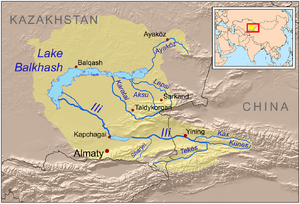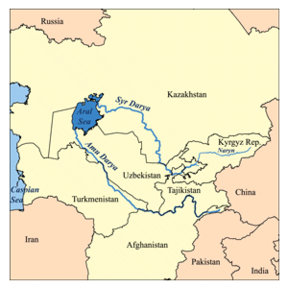Alma-Ata
| Author:Laxman Burdak, IFS (Retd.) |


Alma-Ata or Alma Ata or Almaty (Kazakh: Алматы / Almatı) was the former capital of Kazakhstan till 1997 and the nation's largest city.
Location
The city is located in the mountainous area of southern Kazakhstan, near the border with Kyrgyzstan.
Origin of name
The name Almaty has its roots in medieval settlement Almatu, that existed near the present-day city. There is a theory, which is disputed, that the city derives its name from the Kazakh word for 'apple' (алма), and thus is often translated as "full of apples;" alma is also 'apple' in other Turkic languages, as well as in Hungarian and Mongolian. The Russian version of its name - Alma-Ata, used during the Soviet era - was often perceived by as a combination of two Kazakh words, meaning Father of Apples.
History
Almaty was the capital of the Kazakh SSR from 1929 to 1991 and of independent Kazakhstan from 1991 to 1997. Despite losing its status as the capital to Astana in 1997, Almaty remains the major commercial and cultural centre of Kazakhstan, having direct rail connection with China.
Early history
During 1000–900 BC in the Bronze Age the first farmers and cattle-breeders established settlements on the territory of Almaty.
During the Saka period (from 700 BC to the beginning of the Common Era), these lands were chosen for residence by Saka tribes and later Wusun tribes who inhabited the territory north of the Tian Shan mountain range. Evidence of these times can be found in the numerous burial mounds (tumuli) and ancient settlements, especially the giant burial mounds of the Saka tsars. The most famous archaeological finds have been the "Golden man" from the Issyk Kurgan, the Zhalauly treasure, the Kargaly diadem, and the Zhetysu arts bronzes (boilers, lamps and altars).
During the period of Saka and Wusun governance, Almaty became an early educational centre.
The next stage of Almaty evolution was the period of the Middle Ages (8–10th centuries) and was characterized by the development of a city culture, a transfer to a settled way of living, the development of farming and handicrafts, and the emergence of a number of towns and cities in the territory of Zhetysu.
In the 10–14th centuries, settlements in the territory of the so-called "Greater Almaty" became part of the trade routes of the Silk Road. At that time, Almaty became one of the trade, craft and agricultural centres on the Silk Road and possessed an official mint. The city was first mentioned as Almatu in books from the 13th century.
In the 15th–18th centuries, the city was in decline as trade activities were decreasing on this part of the Silk Road. Notwithstanding, this period was saturated with very important political events that had a significant impact on the history of Almaty and Kazakhstan as a whole. It was a period of crucial ethnic and political transformations. The Kazakh state and nation were founded here, close to Almaty.
These lands also witnessed tragic developments related to the Dzungar intervention and the rigorous efforts of the Kazakh people to protect their land and preserve independence. In 1730 the Kazakhs defeated the Dzungar in the Anyrakay mountains, 70 km north-west of Almaty. It was a critical moment in the Patriotic War between the Kazakhs and the Dzungars. It was later part of the Khanate of Kokand before the Russian conquest in 1854.
Jats, Their Settlements and Strongholds in Eurasia
Mangal Sen Jindal[1] quotes Professor Cothburn Oneal in his work “Conquests of Tamerlane” published by Avon Publications Inc. 575 Madison Avenue – New York 22. This book mentions following cities as ‘Jat Strongholds’ in Russia and near about:
1. Almalyk (Alma – Ata): Pages 97, 232
2. Bokhara: Page 125,
3. Khojend (Khokand) now Ferghana, page 125,
4. Karshi (now Bek – Budi): Page 125,
5. Samarkand: Pages 103, 104, 106
6. Tashkant: Pages 108, 110
7. Otrar: Page 108
Jats who were residing there in strongholds in large numbers and were a source of permanent trouble to Timur-lung settled Uzbekistan.

